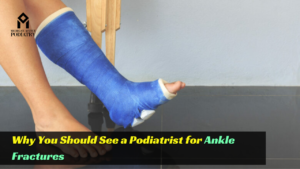Foot and ankle surgery problems can significantly impact one’s quality of life, often requiring surgical intervention to alleviate pain and restore function. As specialized medical professionals, podiatrists, or foot doctors, play a vital role in diagnosing and treating a wide range of foot and ankle conditions. In this informative guide, we’ll delve into eight common types of foot and ankle surgery, shedding light on their purposes, procedures, and expected outcomes.
8 Types of Foot and Ankle Surgery
- Bunion Surgery:
Bunions are bony bumps that form at the base of the big toe, often causing pain and deformity. Bunion surgery, or bunionectomy, aims to realign the bones of the big toe joint, typically by removing the bony protrusion and correcting any misalignment. Depending on the severity of the bunion, various surgical techniques may be employed, including osteotomy (bone cutting) and arthrodesis (joint fusion).
- Hammertoe Correction:
Hammertoe is a condition characterized by an abnormal bend in one or more of the toe joints, leading to discomfort and difficulty wearing shoes. Hammertoe correction surgery involves straightening the affected toe(s) by removing a small section of bone or releasing tight tendons. This procedure helps improve toe alignment and alleviate pain, allowing for better mobility and shoe fit.
- Plantar Fascia Release:
Plantar fasciitis is a common cause of heel pain, resulting from inflammation of the plantar fascia, a thick band of tissue that supports the arch of the foot. Plantar fascia release surgery aims to relieve tension on the plantar fascia by partially cutting or releasing the tight band of tissue. This procedure can effectively reduce heel pain and improve mobility, especially in cases where conservative treatments have been unsuccessful.
- Achilles Tendon Repair:
The Achilles tendon, located at the back of the ankle, is essential for walking, running, and jumping. Achilles tendon repair surgery may be necessary to treat a ruptured or torn Achilles tendon, typically caused by sudden force or overuse. Surgical techniques for Achilles tendon repair may involve stitching the torn tendon back together or using tendon grafts to reinforce the repair.
- Ankle Fusion (Arthrodesis):
Ankle fusion, or arthrodesis, is a surgical procedure that involves fusing the bones of the ankle joint together to alleviate pain and stabilize the ankle. This procedure is often recommended for patients with severe arthritis or joint damage that cannot be effectively treated with conservative measures. Ankle fusion surgery aims to reduce pain, improve joint function, and prevent further degeneration of the ankle joint.
- Ankle Replacement (Arthroplasty):
Ankle replacement, or arthroplasty, is a surgical procedure that involves replacing a damaged or arthritic ankle joint with an artificial implant. This procedure is designed to restore mobility, reduce pain, and improve overall function in patients with advanced ankle arthritis. Ankle replacement surgery may be considered for individuals who have not responded to conservative treatments and are experiencing significant limitations in daily activities.
- Neuroma Removal:
A neuroma is a painful condition characterized by a thickening of the tissue around a nerve, commonly occurring between the metatarsal bones in the ball of the foot. Neuroma removal surgery aims to excise the enlarged nerve or release pressure on the affected area, providing relief from pain and discomfort. This procedure can help restore normal sensation and function in the foot, allowing for improved mobility and comfort.
- Tendon Transfer:
Tendon transfer surgery involves repositioning or rerouting a tendon from one part of the foot or ankle to another to restore function and stability. This procedure is often used to correct deformities, improve muscle balance, or compensate for tendon deficiencies. Tendon transfers may be performed in conjunction with other surgical techniques to achieve optimal outcomes in patients with complex foot and ankle conditions.
Conclusion:
Foot and ankle surgery encompasses a diverse range of procedures aimed at addressing a variety of conditions, from bunions and hammertoes to arthritis and tendon injuries. As trusted healthcare providers, podiatrists play a crucial role in diagnosing foot and ankle problems and recommending appropriate treatment options, including surgical intervention when necessary. If you’re experiencing foot or ankle pain or discomfort, don’t hesitate to consult with a qualified podiatrist to explore your treatment options and regain mobility and quality of life.




